
Residenz, Munich
Encyclopedia
The Munich Residenz is the former royal palace of the Bavaria
n monarchs in the center of the city of Munich
, Germany. The Residenz is the largest city palace in Germany and is today open to visitors for its architecture and room decorations, and displays from the former royal collections.
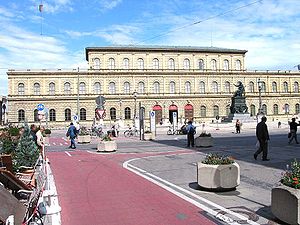 The complex of buildings contains ten courtyards and the museum displays 130 rooms. The three main parts are the Königsbau (near the Max-Joseph-Platz), the Alte Residenz (towards the Residenzstraße) and the Festsaalbau (towards the Hofgarten
The complex of buildings contains ten courtyards and the museum displays 130 rooms. The three main parts are the Königsbau (near the Max-Joseph-Platz), the Alte Residenz (towards the Residenzstraße) and the Festsaalbau (towards the Hofgarten
). A wing of the Festsaalbau contains the Cuvilliés Theatre
since the reconstruction of the Residenz after World War II. It also houses the Herkulessaal (Hercules Hall), the primary concert venue for the Bavarian Radio Symphony Orchestra
.
 The first buildings at this site were erected in the year 1385. The sturdy new castle (Neuveste - new fortress), surrounded by wide moats at what used to be the very north eastern corner of the new double ring of walls, replaced the difficult to defend Old Court
The first buildings at this site were erected in the year 1385. The sturdy new castle (Neuveste - new fortress), surrounded by wide moats at what used to be the very north eastern corner of the new double ring of walls, replaced the difficult to defend Old Court
in the middle of the town as residence of the Wittelsbach
rulers. The dukes of the often divided country felt the urge to keep some distance from the frequently rebellious city dwellers at the one hand and for some defense against their warlike relatives at the other. So they sought to build themselves a shelter impregnable and easy to leave (directly towards the glacis, without having to enter city lanes) at the same time. The gothic
foundation walls and the basement vaults of the old castle are the oldest surviving parts of the palace. The Residenz's development over the centuries didn't only take place out of its main nucleus, the Neuveste, but in addition it grew together out of several single parts and extensions, the first of which used to be the Antiquarium (see below). Finally, after more than four centuries of development, the giant palace had practically replaced a whole former city quarter with barracks, a monastery, houses and gardens. It assembles the styles of the late Renaissance
, as well as of Baroque
, Rococo
and Classicism
.
Maximilian I (1597–1651) commissioned what is now called the Old Residenz (Alte Residenz), the west wing of the palace. Today's admeasurements are from the times of Ludwig I of Bavaria
(1825–1848), who instructed his architect Leo von Klenze
to build the King's tract (Königsbau) in the south in the style of the Florentine
Palazzo Pitti
, the neoclassical 250 m-long Banqueting Hall wing (Festsaalbau) in the north and the Byzantine Court Church of All Saints (Allerheiligen-Hofkirche
) at the east side. Facing the church, the Marstall, the building for the former Court Riding School and the royal stables, was erected by Klenze in 1817-1822. The Max-Joseph Denkmal at Max-Joseph-Platz
before the Königsbau, was created as a memorial for King Maximilian Joseph by Christian Daniel Rauch
and carried out by Johann Baptist Stiglmaier, but only revealed in 1835 since the king had rejected to be eternalized in sitting position.
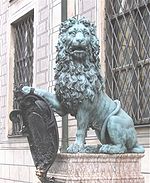 The Winter Garden
The Winter Garden
was commissioned by Ludwig II of Bavaria
. After the king’s death, the Winter Garden on the roof of the Festsaalbau of the Residenz Palace (ca. 1870) was dismantled in 1897 because of water leaking from the ornamental lake through the ceiling of the rooms below. Photographs and sketches still record this incredible creation which included a grotto, a Moorish kiosk, an Indian royal tent, an artificially illuminated rainbow and intermittent moonlight.
(1579–1597) by Friedrich Sustris
as the leading architect, the Brunnenhof (Fontain Court) served for tournaments before the large Wittelsbach Fountain was erected in the middle of the court in 1610. Other yards are the Kapellenhof (Chapel Court), the Kaiserhof (Emperor's Court), the Apothekenhof (Apothecary Court), the Puderhöfchen (Small Powder Court), the Königsbauhof (King's Tract Court), the Küchenhof (Kitchen Court), the Kabinettsgarten (Cabinet Garden), and the finally the Zierhöfchen (Decorative Court).
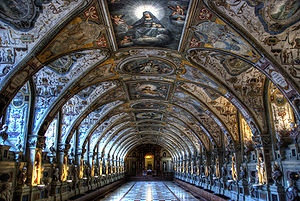 The Hall of Antiquities (Antiquarium), built in 1568-1571 for the antique collection of Albert V
The Hall of Antiquities (Antiquarium), built in 1568-1571 for the antique collection of Albert V
(1550–1579) by Wilhelm Egkl and Jacobo Strada
, is the largest Renaissance hall north of the Alps. Remodeled into a banquet hall by Friedrich Sustris in 1586-1600. The Antiquarium housed the ducal library until 1581. The low hall was then covered with a barrel vault that had 17 window lunettes. The hall was adorned with paintings by Peter Candid, Antonio Ponzano, and Hans Thonauer the Elder, though some were initially designed by Sustris himself. The Court Chapel (Hofkapelle), the Emperor's Staircase (Kaisertreppe) and Imperial Hall (Kaisersaal), the Stone Rooms (Steinzimmer; 1612–1617; general design by Hans Krumpper
) and the Trier Rooms (Trierzimmer); ceiling frescoes by Peter Candid
) built for Maximilian I
are typical for the early 17th century.
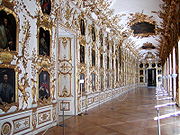 The baroque era is represented by the Papal Rooms (Päpstlichen Zimmer), erected under his son Ferdinand Maria
The baroque era is represented by the Papal Rooms (Päpstlichen Zimmer), erected under his son Ferdinand Maria
(1651–1679). The Ancestral Gallery (Ahnengallerie; 1726–1731) with the Porcelain Cabinet (both constructed by Joseph Effner
) and the Ornate Rooms (Reichen Zimmer) designed by François de Cuvilles for Charles Albert
(1726–1745) are magnificent examples for the court Rococo style. Under Maximilian III
(1745–1777) the Apartments of the Elector (Kurfürstenzimmer) were constructed between 1746 and 1763. Also the Residenz Theatre
was added under Maximilian III.
The neoclassical epoch is represented especially by the Charlotte Rooms (Charlottenzimmer) but also by the Royal Apartments and the Halls of the Battles (Schlachtensäle) in the Königsbau. The wall and the ceiling paintings by Julius Schnorr von Carolsfeld
in the Nibelungensäle (Nibelungen Halls; 1827–1834) produced in the same period are the first monumental representations of the Nibelungenlied
.
Additionally to the rich accumulation of furniture, paintings and sculptures, the museum contains bronze work, clocks, tapestries, porcelain and several special collections.
The Festsaalbau also houses the Bavarian Academy of Sciences and Humanities
while the Bavarian Academy of Fine Arts is situated in the Königsbau. One of the primary concert venues for the Bavarian Radio Symphony Orchestra
is the Herkulessaal (Hercules Hall) in the Festsaalbau of the Residenz.
 Founded by Albert V
Founded by Albert V
the house jewels of the Wittelsbach
are today on display in the treasury (Schatzkammer), ten halls in the east wing of the Königsbau. The collection is one of the most important in the world and spans 1000 years from the early Middle Ages to Classicism. On display are royal insignia, crowns, swords, goblets, goldsmith work, rock crystal, ivory work, icons and numerous other treasures like precious tableware and toiletries.
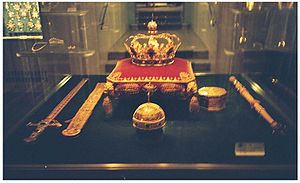 Among the exhibits are for example Emperor Charles the Bald's
Among the exhibits are for example Emperor Charles the Bald's
prayer-book (ca. 860), the altar-ciborium of Emperor Arnulf of Carinthia
(ca. 890), the crown of the Empress Cunigunde, reliquary of the True Cross which belonged to the Emperor Henry II
, a cross which belonged to Queen Gisela
(all ca. 1000), the Reliquary Crown of Henry II
(ca. 1270), an English Queen's crown
(ca. 1370; The oldest surviving crown of England that came to the palatinian line of the house of Wittelsbach as dowry of the daughter of Henry IV
), the famous Statuette of St George (Munich, ca. 1599), the insignia and orders of the Bavarian kings, including crowns and insignia
of the Emperor Charles VII
(1742), the Crown of Bavaria
(1804), ceremonial swords and ruby jewelry which belonged to Queen Therese
. A precious set of matching dishes served the French Empress Marie Louise
during her journeys. Also Non-European art and craftwork, including Chinese porcelain, ivories from Ceylon and captured Turkish daggers are shown.
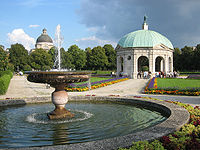 The Court Garden (Hofgarten) at the northern side opposite to the Festsaalbau was laid out under Maximilian I. In the middle of the park in French style a circular temple (1615) is crowned by a statue of Bavaria (1594 by Hubert Gerhard). The eastern Hofgarten arcades with the gate were done by Klenze, the northern wing with the former electoral gallery houses a theatre museum. The renaissance arcades in the north east of the park were integrated to the Bavarian State Chancellery in 1992. (The people of Munich love to denounce it as Straussoleum, after a former state prime minister who commissioned it, or even Munich White House, in reference to the long and hard fights that prevented the state government from erecting three giant wings instead of one. These wings supposedly have destroyed the impression of the court gardens. Its middle section with the now reconstructed dome is the only remnant of the former Bavarian Army Museum, constructed already in 1900-1905 and almost completely destroyed during the bomb raids of World War II. That museum is nowadays located in the Neues Schloss in the city of Ingolstadt, 80 km north of Munich.
The Court Garden (Hofgarten) at the northern side opposite to the Festsaalbau was laid out under Maximilian I. In the middle of the park in French style a circular temple (1615) is crowned by a statue of Bavaria (1594 by Hubert Gerhard). The eastern Hofgarten arcades with the gate were done by Klenze, the northern wing with the former electoral gallery houses a theatre museum. The renaissance arcades in the north east of the park were integrated to the Bavarian State Chancellery in 1992. (The people of Munich love to denounce it as Straussoleum, after a former state prime minister who commissioned it, or even Munich White House, in reference to the long and hard fights that prevented the state government from erecting three giant wings instead of one. These wings supposedly have destroyed the impression of the court gardens. Its middle section with the now reconstructed dome is the only remnant of the former Bavarian Army Museum, constructed already in 1900-1905 and almost completely destroyed during the bomb raids of World War II. That museum is nowadays located in the Neues Schloss in the city of Ingolstadt, 80 km north of Munich.
Bavaria
Bavaria, formally the Free State of Bavaria is a state of Germany, located in the southeast of Germany. With an area of , it is the largest state by area, forming almost 20% of the total land area of Germany...
n monarchs in the center of the city of Munich
Munich
Munich The city's motto is "" . Before 2006, it was "Weltstadt mit Herz" . Its native name, , is derived from the Old High German Munichen, meaning "by the monks' place". The city's name derives from the monks of the Benedictine order who founded the city; hence the monk depicted on the city's coat...
, Germany. The Residenz is the largest city palace in Germany and is today open to visitors for its architecture and room decorations, and displays from the former royal collections.

Hofgarten (München)
The Hofgarten is a garden in the center of Munich, Germany, located between the Residenz and the Englischer Garten.The garden was built in 1613-1617 by Maximilian I, Elector of Bavaria as an Italian style Renaissance garden. In the center of the garden is a pavilion for the goddess Diana, built in...
). A wing of the Festsaalbau contains the Cuvilliés Theatre
Cuvilliés Theatre
The Cuvilliés Theatre or Old Residence Theatre is the former court theatre of the Residenz in Munich, southern Germany.- Description :...
since the reconstruction of the Residenz after World War II. It also houses the Herkulessaal (Hercules Hall), the primary concert venue for the Bavarian Radio Symphony Orchestra
Bavarian Radio Symphony Orchestra
The Bavarian Radio Symphony Orchestra, in German Symphonieorchester des Bayerischen Rundfunks is the internationally renowned orchestra of the Bayerischer Rundfunk , based in Munich, Germany. It is one of the three principal orchestras in the city of Munich, along with the Munich Philharmonic...
.
Architecture

Alter Hof
The Alte Hof in the center of Munich is the former imperial residence of Louis IV, Holy Roman Emperor and consists of five wings Burgstock, Zwingerstock, Lorenzistock, Pfisterstock and Brunnenstock....
in the middle of the town as residence of the Wittelsbach
Wittelsbach
The Wittelsbach family is a European royal family and a German dynasty from Bavaria.Members of the family served as Dukes, Electors and Kings of Bavaria , Counts Palatine of the Rhine , Margraves of Brandenburg , Counts of Holland, Hainaut and Zeeland , Elector-Archbishops of Cologne , Dukes of...
rulers. The dukes of the often divided country felt the urge to keep some distance from the frequently rebellious city dwellers at the one hand and for some defense against their warlike relatives at the other. So they sought to build themselves a shelter impregnable and easy to leave (directly towards the glacis, without having to enter city lanes) at the same time. The gothic
Gothic architecture
Gothic architecture is a style of architecture that flourished during the high and late medieval period. It evolved from Romanesque architecture and was succeeded by Renaissance architecture....
foundation walls and the basement vaults of the old castle are the oldest surviving parts of the palace. The Residenz's development over the centuries didn't only take place out of its main nucleus, the Neuveste, but in addition it grew together out of several single parts and extensions, the first of which used to be the Antiquarium (see below). Finally, after more than four centuries of development, the giant palace had practically replaced a whole former city quarter with barracks, a monastery, houses and gardens. It assembles the styles of the late Renaissance
Renaissance
The Renaissance was a cultural movement that spanned roughly the 14th to the 17th century, beginning in Italy in the Late Middle Ages and later spreading to the rest of Europe. The term is also used more loosely to refer to the historical era, but since the changes of the Renaissance were not...
, as well as of Baroque
Baroque
The Baroque is a period and the style that used exaggerated motion and clear, easily interpreted detail to produce drama, tension, exuberance, and grandeur in sculpture, painting, literature, dance, and music...
, Rococo
Rococo
Rococo , also referred to as "Late Baroque", is an 18th-century style which developed as Baroque artists gave up their symmetry and became increasingly ornate, florid, and playful...
and Classicism
Classicism
Classicism, in the arts, refers generally to a high regard for classical antiquity, as setting standards for taste which the classicists seek to emulate. The art of classicism typically seeks to be formal and restrained: of the Discobolus Sir Kenneth Clark observed, "if we object to his restraint...
.
Maximilian I (1597–1651) commissioned what is now called the Old Residenz (Alte Residenz), the west wing of the palace. Today's admeasurements are from the times of Ludwig I of Bavaria
Ludwig I of Bavaria
Ludwig I was a German king of Bavaria from 1825 until the 1848 revolutions in the German states.-Crown prince:...
(1825–1848), who instructed his architect Leo von Klenze
Leo von Klenze
Leo von Klenze was a German neoclassicist architect, painter and writer...
to build the King's tract (Königsbau) in the south in the style of the Florentine
Florence
Florence is the capital city of the Italian region of Tuscany and of the province of Florence. It is the most populous city in Tuscany, with approximately 370,000 inhabitants, expanding to over 1.5 million in the metropolitan area....
Palazzo Pitti
Palazzo Pitti
The Palazzo Pitti , in English sometimes called the Pitti Palace, is a vast mainly Renaissance palace in Florence, Italy. It is situated on the south side of the River Arno, a short distance from the Ponte Vecchio...
, the neoclassical 250 m-long Banqueting Hall wing (Festsaalbau) in the north and the Byzantine Court Church of All Saints (Allerheiligen-Hofkirche
Allerheiligen-Hofkirche
The Allerheiligen-Hofkirche is a church in the Munich Residence designed by Leo von Klenze and built between 1826 and 1837. The church was badly damaged from bombing during World War II and for decades remained a ruin before undergoing partial restoration and secularization...
) at the east side. Facing the church, the Marstall, the building for the former Court Riding School and the royal stables, was erected by Klenze in 1817-1822. The Max-Joseph Denkmal at Max-Joseph-Platz
Max-Joseph-Platz
Max-Joseph-Platz is a large square in central Munich which was named after King Maximilian Joseph. Max-Joseph-Platz serves as the western starting point of the royal avenue Maximilianstraße.-Architecture:...
before the Königsbau, was created as a memorial for King Maximilian Joseph by Christian Daniel Rauch
Christian Daniel Rauch
Christian Daniel Rauch was a German sculptor. He founded the Berlin school of sculpture, and was the foremost German sculptor of the 19th century.-Biography:Rauch was born at Arolsen in the Principality of Waldeck...
and carried out by Johann Baptist Stiglmaier, but only revealed in 1835 since the king had rejected to be eternalized in sitting position.

Winter Garden
Winter Garden may refer to:* A winter garden, winter-hardy plants grown for winter interest and decoration, or to be harvested for food between winter and early spring.-Places:* Winter Garden, California, former community in Kern County...
was commissioned by Ludwig II of Bavaria
Ludwig II of Bavaria
Ludwig II was King of Bavaria from 1864 until shortly before his death. He is sometimes called the Swan King and der Märchenkönig, the Fairy tale King...
. After the king’s death, the Winter Garden on the roof of the Festsaalbau of the Residenz Palace (ca. 1870) was dismantled in 1897 because of water leaking from the ornamental lake through the ceiling of the rooms below. Photographs and sketches still record this incredible creation which included a grotto, a Moorish kiosk, an Indian royal tent, an artificially illuminated rainbow and intermittent moonlight.
Courtyards
Ten yards can be found inside the large complex: The Grotto Courtyard (Grottenhof) with the Perseus Fontain was built between 1581-1586 under William VWilliam V, Duke of Bavaria
William V, Duke of Bavaria , called the Pious, was Duke of Bavaria from 1579 to 1597.- Education and early life :...
(1579–1597) by Friedrich Sustris
Friedrich Sustris
Friedrich Sustris was a German-Dutch painter, decorator and architect. He was a son of the artist Lambert Sustris, who worked in Italy....
as the leading architect, the Brunnenhof (Fontain Court) served for tournaments before the large Wittelsbach Fountain was erected in the middle of the court in 1610. Other yards are the Kapellenhof (Chapel Court), the Kaiserhof (Emperor's Court), the Apothekenhof (Apothecary Court), the Puderhöfchen (Small Powder Court), the Königsbauhof (King's Tract Court), the Küchenhof (Kitchen Court), the Kabinettsgarten (Cabinet Garden), and the finally the Zierhöfchen (Decorative Court).
World War II damage
The palace was severely damaged by bombing during World War II, but most of the rooms were reconstructed by the 1980s. Some of the buildings, however, had been remade in a simplified manner. Examples are the facade of the Alte Residenz on Residenzstrasse or the Arcades in front of the former throne hall on the first floor of the Festsaalbau. A substantial loss especially is the destruction of the neo-classical rooms in the Festssalbau (including the Grand Throne Hall, which is now Hercules Concert Hall), the destruction of the rich décor of the Papal Rooms and of all the frescoes of the Court Church of All Saints.Inside the palace

Albert V, Duke of Bavaria
Albert V was Duke of Bavaria from 1550 until his death. He was born in Munich to William IV and Marie Jacobaea of Baden.-Early life:Albert was educated at Ingolstadt under good Catholic teachers...
(1550–1579) by Wilhelm Egkl and Jacobo Strada
Jacopo Strada
Jacopo Strada was an Italian polymath courtier of the 16th century, a painter, architect, goldsmith, inventor of machines, numismatist, linguist, collector and merchant of works of art...
, is the largest Renaissance hall north of the Alps. Remodeled into a banquet hall by Friedrich Sustris in 1586-1600. The Antiquarium housed the ducal library until 1581. The low hall was then covered with a barrel vault that had 17 window lunettes. The hall was adorned with paintings by Peter Candid, Antonio Ponzano, and Hans Thonauer the Elder, though some were initially designed by Sustris himself. The Court Chapel (Hofkapelle), the Emperor's Staircase (Kaisertreppe) and Imperial Hall (Kaisersaal), the Stone Rooms (Steinzimmer; 1612–1617; general design by Hans Krumpper
Hans Krumpper
Hans Krumpper was a German sculptor, plasterer, architect and intendant of the arts who served the Bavarian dukes William V...
) and the Trier Rooms (Trierzimmer); ceiling frescoes by Peter Candid
Peter Candid
Peter Candid aka Peter de Witt or Peter de Witte was a Netherlandish Mannerist painter and architect. He moved to Florence as a child with his father, a tapestry weaver, and was trained in Italy. Candid worked with Giorgio Vasari on the Sala Regia in the Vatican and on the cupola of the Florence...
) built for Maximilian I
Maximilian I, Elector of Bavaria
Maximilian I, Duke/Elector of Bavaria , called "the Great", was a Wittelsbach ruler of Bavaria and a prince-elector of the Holy Roman Empire. His reign was marked by the Thirty Years' War ....
are typical for the early 17th century.

Ferdinand Maria, Elector of Bavaria
Ferdinand Maria, Elector of Bavaria was a Wittelsbach ruler of Bavaria and an elector of the Holy Roman Empire from 1651 to 1679.-Biography:He was born in Munich...
(1651–1679). The Ancestral Gallery (Ahnengallerie; 1726–1731) with the Porcelain Cabinet (both constructed by Joseph Effner
Joseph Effner
Joseph Effner was a German architect and decorator.Effner was born in Dachau as a son of the court gardener Christian Öffner. Effner accompanied the elector of Bavaria Max Emanuel to Bruxelles. In 1706 Effner was retrained by Gabriel Germain Boffrand in Paris. Here he changed his family name to...
) and the Ornate Rooms (Reichen Zimmer) designed by François de Cuvilles for Charles Albert
Charles VII, Holy Roman Emperor
Charles VII Albert a member of the Wittelsbach family, was Prince-elector of Bavaria from 1726 and Holy Roman Emperor from 24 January 1742 until his death in 1745...
(1726–1745) are magnificent examples for the court Rococo style. Under Maximilian III
Maximilian III, Elector of Bavaria
Maximilian III Joseph was Prince-elector of the Holy Roman Empire and Duke of Bavaria from 1745 to 1777.-Biography:...
(1745–1777) the Apartments of the Elector (Kurfürstenzimmer) were constructed between 1746 and 1763. Also the Residenz Theatre
Cuvilliés Theatre
The Cuvilliés Theatre or Old Residence Theatre is the former court theatre of the Residenz in Munich, southern Germany.- Description :...
was added under Maximilian III.
The neoclassical epoch is represented especially by the Charlotte Rooms (Charlottenzimmer) but also by the Royal Apartments and the Halls of the Battles (Schlachtensäle) in the Königsbau. The wall and the ceiling paintings by Julius Schnorr von Carolsfeld
Julius Schnorr von Carolsfeld
Julius Schnorr von Carolsfeld was a German painter.-Biography:Schnorr was born at Leipzig, where he received his earliest instruction from his father Johann Veit Schnorr , a draughtsman, engraver and painter...
in the Nibelungensäle (Nibelungen Halls; 1827–1834) produced in the same period are the first monumental representations of the Nibelungenlied
Nibelungenlied
The Nibelungenlied, translated as The Song of the Nibelungs, is an epic poem in Middle High German. The story tells of dragon-slayer Siegfried at the court of the Burgundians, how he was murdered, and of his wife Kriemhild's revenge....
.
Additionally to the rich accumulation of furniture, paintings and sculptures, the museum contains bronze work, clocks, tapestries, porcelain and several special collections.
The Festsaalbau also houses the Bavarian Academy of Sciences and Humanities
Bavarian Academy of Sciences and Humanities
The Bavarian Academy of Sciences and Humanities is an independent public institution, located in Munich. It appoints scholars whose research has contributed considerably to the increase of knowledge within their subject...
while the Bavarian Academy of Fine Arts is situated in the Königsbau. One of the primary concert venues for the Bavarian Radio Symphony Orchestra
Bavarian Radio Symphony Orchestra
The Bavarian Radio Symphony Orchestra, in German Symphonieorchester des Bayerischen Rundfunks is the internationally renowned orchestra of the Bayerischer Rundfunk , based in Munich, Germany. It is one of the three principal orchestras in the city of Munich, along with the Munich Philharmonic...
is the Herkulessaal (Hercules Hall) in the Festsaalbau of the Residenz.
The treasury

Albert V, Duke of Bavaria
Albert V was Duke of Bavaria from 1550 until his death. He was born in Munich to William IV and Marie Jacobaea of Baden.-Early life:Albert was educated at Ingolstadt under good Catholic teachers...
the house jewels of the Wittelsbach
Wittelsbach
The Wittelsbach family is a European royal family and a German dynasty from Bavaria.Members of the family served as Dukes, Electors and Kings of Bavaria , Counts Palatine of the Rhine , Margraves of Brandenburg , Counts of Holland, Hainaut and Zeeland , Elector-Archbishops of Cologne , Dukes of...
are today on display in the treasury (Schatzkammer), ten halls in the east wing of the Königsbau. The collection is one of the most important in the world and spans 1000 years from the early Middle Ages to Classicism. On display are royal insignia, crowns, swords, goblets, goldsmith work, rock crystal, ivory work, icons and numerous other treasures like precious tableware and toiletries.

Charles the Bald
Charles the Bald , Holy Roman Emperor and King of West Francia , was the youngest son of the Emperor Louis the Pious by his second wife Judith.-Struggle against his brothers:He was born on 13 June 823 in Frankfurt, when his elder...
prayer-book (ca. 860), the altar-ciborium of Emperor Arnulf of Carinthia
Arnulf of Carinthia
Arnulf of Carinthia was the Carolingian King of East Francia from 887, the disputed King of Italy from 894 and the disputed Holy Roman Emperor from February 22, 896 until his death.-Birth and Illegitimacy:...
(ca. 890), the crown of the Empress Cunigunde, reliquary of the True Cross which belonged to the Emperor Henry II
Henry II, Holy Roman Emperor
Henry II , also referred to as Saint Henry, Obl.S.B., was the fifth and last Holy Roman Emperor of the Ottonian dynasty, from his coronation in Rome in 1014 until his death a decade later. He was crowned King of the Germans in 1002 and King of Italy in 1004...
, a cross which belonged to Queen Gisela
Giselle of Bavaria
Blessed Gisela of Hungary was the first queen of Hungary.- Biography :Gisela was a daughter of Henry II, Duke of Bavaria and Gisela of Burgundy....
(all ca. 1000), the Reliquary Crown of Henry II
Reliquary Crown of Henry II
The so-called Crown of St. Henry II is a reliquary crown, which belonged to the reliquary of the emperor at the Cathedral of Bamberg. After the process of German Mediatisation the Kingdom of Bavaria came into possession of Bamberg and took the crown to the treasury of Munich Residenz, where it...
(ca. 1270), an English Queen's crown
Palatine Crown
The Palatine Crown or Bohemian Crown is the oldest surviving crown of England. It was produced from gold, enamel, sapphires, rubies, emeralds, diamonds and pearls .- History :...
(ca. 1370; The oldest surviving crown of England that came to the palatinian line of the house of Wittelsbach as dowry of the daughter of Henry IV
Henry IV of England
Henry IV was King of England and Lord of Ireland . He was the ninth King of England of the House of Plantagenet and also asserted his grandfather's claim to the title King of France. He was born at Bolingbroke Castle in Lincolnshire, hence his other name, Henry Bolingbroke...
), the famous Statuette of St George (Munich, ca. 1599), the insignia and orders of the Bavarian kings, including crowns and insignia
Imperial Crowns of Charles VII
The Imperial Crowns of Charles VII are kept in the treasury at the Munich Residenz. Since the imperial crown was merely used as coronation crown, the Holy Roman Emperors had to use different crowns for all other purposes. While the Habsburg were in possession of own imperial crowns, Charles VII...
of the Emperor Charles VII
Charles VII, Holy Roman Emperor
Charles VII Albert a member of the Wittelsbach family, was Prince-elector of Bavaria from 1726 and Holy Roman Emperor from 24 January 1742 until his death in 1745...
(1742), the Crown of Bavaria
Crown of Bavaria
The Crown of the King of Bavaria was ordered and designed 1804-1807 for Maximilian I after Napoleon had raised Bavaria to kingdom status. It was commissioned to the French goldsmith Jean-Baptiste de Lasne, who drew inspiration from the crown of Louis XV of France.Maximilian's alliance with Emperor...
(1804), ceremonial swords and ruby jewelry which belonged to Queen Therese
Therese of Saxe-Hildburghausen
Therese Charlotte Luise of Saxony-Hildburghausen was a queen of Bavaria.She was a daughter of Frederick, Duke of Saxe-Altenburg, and Duchess Charlotte Georgine of Mecklenburg-Strelitz, eldest daughter of Charles II, Grand Duke of Mecklenburg-Strelitz.-Biography:In 1809, she was on the list of...
. A precious set of matching dishes served the French Empress Marie Louise
Marie Louise, Duchess of Parma
Marie Louise of Austria was the second wife of Napoleon I, Emperor of the French and later Duchess of Parma...
during her journeys. Also Non-European art and craftwork, including Chinese porcelain, ivories from Ceylon and captured Turkish daggers are shown.
The coin collection
Founded already by Albert V. the Residenz houses also the Bavarian state's coin collection. With more than 300,000 coins, medals and banknotes from the ancient world to the present time it is one of the world's leading collections.The Court Garden


